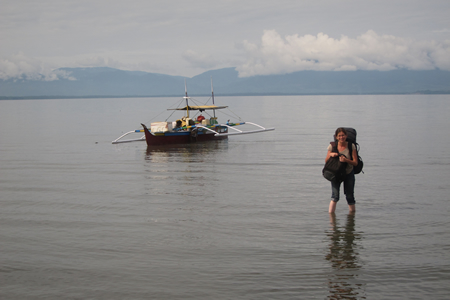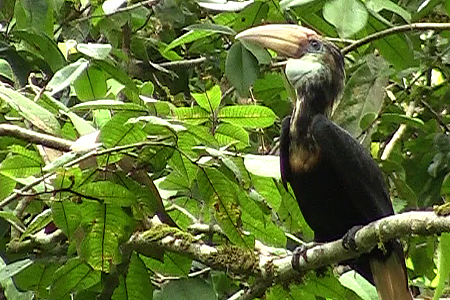English | Dutch |
|
| Remote Halmahera: Foli | |
Ambon (Indonesia), May 8th 2012
|
|
| |
|
Already three years ago we had the plan to bring a visit to the North Moluccan island Halmahera. Halmahera is the biggest of the North Moluccan islands and is a great place to see many of the North Moluccan endemic birds. Three years ago, we were already on the nearby volcanic island of Ternate, but due to continuous bad weather back then, we had to cancel our plans. But this year we came back. And his time with more luck. We flew from the city of Manado in Sulawesi with a small propeller plane of Wings Air to a small Halmahera village with the name Kao. Our final destination for that day was Tobelo, the only settlement on Halmahera that can be called a ‘town’. A couple of days earlier, Ivonne was frequently bitten by mites in Tangkoko NP in Northern Sulawesi, and because of the allergic reaction (swollen feet and liquid blisters), we had to take a rest day to let things heal. From Tobelo we took a shared car (the main form of public transport on Halmahera) to Daru. Daru is a small fishing village from where small boats serve settlements on the north-eastern peninsula of the whimsical formed island of Halmahera. Our travel destination was the small settlement Foli where 800 people live. Infrequent public boats serve these settlements on an erratic schedule, so we had to hire our own boat. It was still early in the morning, the sea was still calm, which meant that a very small ‘palm boat’ with outriggers should be big enough to make the crossing safely. Of course, as everywhere in Indonesia, we had to settle the price first. After some negotiations we agreed a price of 250,000 Rupiahs (Euro 20) for the one-hour passage. |
|
 |
|
Arrival in Foli |
|
Halfway the crossing, our boat broke down. The boatman overlooked a floating bamboo stick which destroyed the tiny screw propeller of the boat. It probably happens more often, because he had some spare ones in his boat. Twenty minutes later everything was fixed again. When we approached Foli we immediately realised that we arrived in the ‘middle of nowhere’. Foli has no boat landing which meant that we had to wade the last hundred metres through the delightful warm water. Our arrival was quickly noticed. People from everywhere in the village came to the beach front to observe the arrival of the ‘orang putih’ (white people). It is usual to report yourself at the village head when you arrive in a small and remote Indonesian village. So when we asked for the ‘kepala desa’, an older man came to the fore to accompany us to the house of the village head. The village head is most of the time also the person in the village who has basic accommodation available for passing travellers. And because Foli is visited by birders on a regular basis, the village head was prepared, despite the fact that we didn’t announce our visit. The family of the village head has some very basic rooms (boxes) in a separate wooden building. The boxes have no lights and they only contain two wooden beds. Fortunately, the village head had some foam mattresses available, which increased the chance of a comfortable night of sleep significantly. There is also a communal area with wooden benches. For the bathroom and shower, you have to use the facilities of the family. The toilet is a separate little building with a squad toilet behind the house. Flushing the toilet is done by scooping water from a bucket into the toilet. The shower is a different little building with a concrete floor, in where a big barrel of water is placed. Again, a plastic beaker is used to scoop the water out of the barrel, and this time over your head to wash yourself. It is important to keep the water in the barrel (called mandi in Indonesian) clean, because it is also used by following users. | |
 |
|
A female Blyth's Hornbill |
|
| We arranged with the village head that we do not only use his accommodation, but that we also wanted to have three meals a day. The village is very small, and more than a little shop for basic necessities, is not available. Despite the fact that we didn’t have any alternatives, we ask for the price; just to avoid surprises at the end of our stay when we get the bill. The prices appeared to be steep. A bed in the little box costs 100,000 Rupiahs (a little bit more than Euro 8), which make the price for a two-person room a staggering 200,000 Rupiahs! The food costs an additional 125,000 Rupiahs per person (Euro 12) for three meals a day. And that is a lot for Indonesian standards. For 200,000 Rupiahs you can have a middle class hotel room in the city, often with breakfast. And for 125,000 Rupiahs per person per day, you can eat a lot of delicious food in the Indonesian archipelago. The biggest disappointment however was the fact that they didn’t do a lot of efforts to make some nice meals, which must be possible for these amounts of money, even in a remote village like Foli. In the morning we got Nasi Goreng (fried rice), while the lunches and dinners wasn’t more than watery soup, rice, a vegetable dish and a piece of fish or skinny chicken.
The village of Foli is on walking distance from the ‘forests’ where many of the North Moluccan endemics can be found. The original forest is completely chopped, and the area now consists of younger tree and a lot of bushes. But still, many species of birds can be found here. However, trip reports show that is becomes more and more difficult to see certain species. It is known for example that some species are very popular cage birds (like the White Cockatoo and the Chattering Lory), which results in the fact that more than 10% of the population of these birds is caught on a yearly basis. This is of course a destructive catch rate. Later, during our stay in the hotel Losmen Kita in Kota Ternate, we were eyewitness of the sad future for many of these birds. Losmen Kita alone had four White Cockatoos and four Chattering Lories small cages in the courtyard of the hotel. Very sad! We stay two and a half days in Foli and see the most common species that can be found in the area around Foli, including exotic doves and pigeons, spectacular Lories and Parrots, several species of raptors and the two species of Birds of Paradise that can be found on Halmahera: the Wallace’s Standard wing and the Paradise-Crow. Our visit to Foli was absolutely worthwhile. At the end of our visit to Foli, the village head arranged two places on a public boat back to Daru. However, the public boat wasn’t really a cost saving in comparison to the chartered boat that brought us to Foli. We still had to pay an inflated 100,000 Rupiahs per person, which meant that the village head sucked money out of us till the last moment. A little bit of competition in the village would be a good development. It would mean that prices would become more reasonable and that the money spent by visitors, would be distributed over more than one family. | |